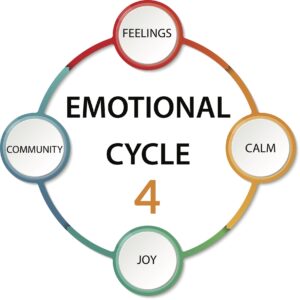Have you ever wondered how some people always manage to maintain a positive mindset or achieve success in life, even when they’re going through stressful situations? A lot of times it has to do with that person’s ability to reframe stress. It’s an incredible skill to master, and if we can teach our students positive ways to reframe their stress, we’ll be helping them take a huge step to developing better emotional literacy.
What is ‘reframing’?
Reframing is a type of mindset shift. When you reframe a stressful situation, you change your experience or perspective of what the stressor actually is and how the stressful situation affects you. You can also use the technique to reframe the way you see yourself, or a certain event, person, or relationship, in order to see those things in a more positive light.

Teaching Students About Positive Reframing
The best way to teach students how to reframe a stressful or negative situation is through modeling. As teachers and/or parents, we should be examples of how our kids should grow, learn, and change. So if you catch yourself saying something like, “I’m so stressed,” correct it by adding, “AND I know that I can get through this,” or “AND I have helpful strategies that I’m going to try.”
The biggest struggle children often have is in dealing with negative self chatter. When their minds are racing with negative thoughts, it’s very difficult for them to try and reframe a stressful situation into something positive.
As educators, we are always focused on helping our students identify their strengths. For example, when students hit elementary age, they get frustrated when something they’re working on doesn’t go right, and they think, “I’m not good at anything,” or, “I can’t do it.” This is an opportunity to remind them of their strengths. You can encourage them to reframe the situation by saying something like, “You have an amazing sense of humor and that helps you look at things differently; how can you bring humor to this project and do it a different way?”

Positive Reframing & the Growth Mindset
The growth mindset, which was coined by Carol Dweck, is a specific reframing technique that involves seeing challenges as opportunities to grow. When your students are stressed, ask them: How can this stressful situation help improve your abilities or help you push yourself?
Using the growth mindset helps replace the negative self-talk with positive self-talk. Something as simple as adding the word “yet” to a statement is also a part of the grown mindset habit. “I can’t do this yet,” implies that there’s room for learning and motivates students to push themselves to grow.
[If you want a deeper dive into the grown mindset theory, check out Dweck’s book, Mindset: The New Psychology of Success!]
One Quick Implementation Strategy: Replace Negative Self-Talk with Positive Self-Talk
Fairly often, when students are bombarded with negative self-talk, it’s challenging to see things—especially stressful things—positively. It’s better to be proactive, rather than reactive. Have students create an art project that focuses on their strengths. This is something they can refer to the next time their negative self-talk gets too loud. Seeing a list of their strengths (especially as a beautiful work of art) can help them focus on positive thoughts as they practice a reframing mindset.
By Spramani Elaun & Kristen Richter
© 2020 All Rights Reserved

